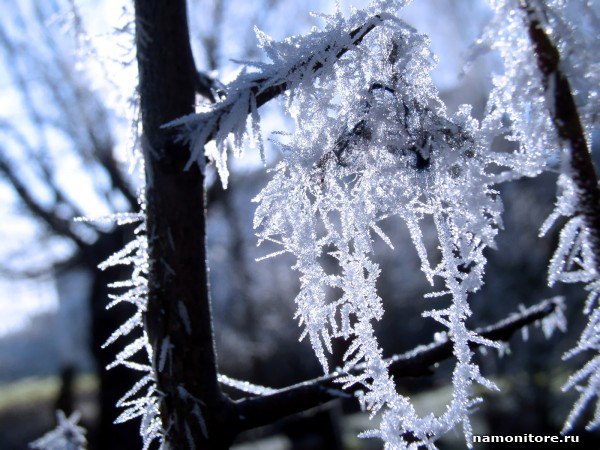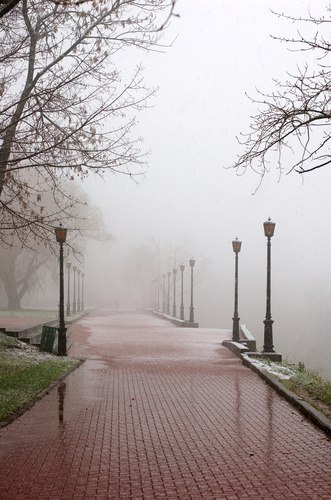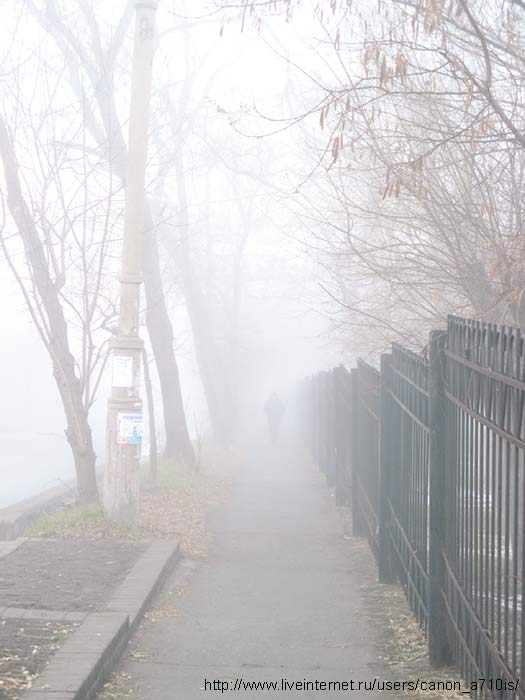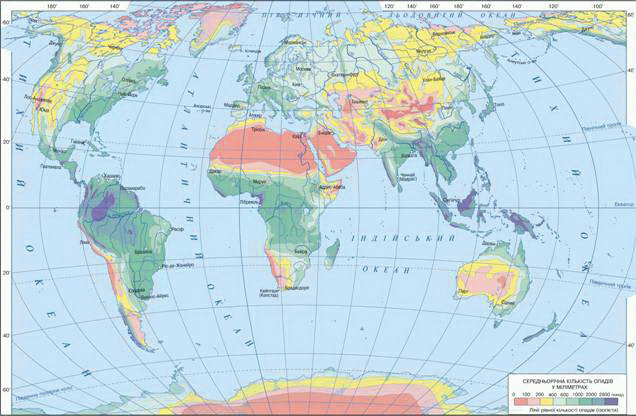Precipitation - water in a liquid or solid state, falling out of clouds or from the air onto the earth's surface and any objects.
Precipitation is measured by the thickness of the precipitated water layer in millimeters. On average the globe about 1000 mm of precipitation falls per year, and in deserts and in high latitudes - less than 250 mm per year.
Heavy rain properties
Imagine a summer thunderstorm with sudden, intense downpours in a short period. Compare this to rain from widespread cloud cover with lighter showers over several hours. The amount of rain that falls in a heavy downpour depends on the amount of water vapor in the atmosphere. At higher temperatures, the atmosphere can contain more water vapor, which increases the likelihood of heavy rainfall. The properties of tropical rainfall are highly dependent on the time studied, for example, from five minutes to several hours or days.
At meteorological stations, precipitation is measured rain gauges.
Precipitation formation.
If the cloud is made up of very small water droplets or ice crystals (less than 0.05 mm), then there will be no precipitation. While they are small and light, they are kept high above the ground by updrafts. Under certain conditions, droplets collide and merge into large droplets. The clouds darken, turn blue-black. Large drops (0.1-7 mm) can no longer stay in the air and fall, forming rain.Snow is formed in the clouds, which at temperatures below 0 0 С consist of the smallest crystals-needles, connected in snowflakes.
Different types of precipitation are created by different processes in the atmosphere. This makes it a challenging area to research. “A summer thunderstorm is a convective type of precipitation, and widespread cloud cover is a stratiform type,” explains Berg by way of illustration.
Temperature change affects the type of shower
When they studied associated periods of sustained rain, they found that heavy convective showers became more intense, and that they maintained that high intensity throughout their duration. Rain from more widespread precipitation areas showed no apparent pattern at altered temperatures.

Hail formed when warm air rises rapidly. It picks up rain clouds and carries them to a height where temperatures drop to -10 0 C. At the same time, the drops freeze and turn into ice balls - hailstones. They range in size from 1 mm to the size of a chicken egg. A hailstone weighing 7 kg, which fell during a hail in China (1981), and in Ukraine - 500 grams, was the record-breaking largest in the world. (1960).
It is necessary to study the processes behind heavy rain
Heavy rain has far-reaching consequences for both nature and society. Heavy rainfall is also a greater threat at higher temperatures, as it maintains its high intensity for a longer period. Although the researchers looked at extreme rainfall at different temperatures, the results cannot be directly applied to climate change scenarios. They encourage further research using cloud and climate models with high resolution, which describe in more detail the processes associated with a heavy shower.

Precipitation can also "fall" out of thin air. This happens on the cooled surface of the earth when it comes into contact with air saturated with moisture.
Dew - drops of water that sometimes cover the ground and plants. It forms after sunset, when the surface of the earth and its air quickly cool. Cold air can no longer contain as much water vapor as it did during the day with more high temperature... Its excess condenses into dew droplets.
The relief has a tremendous effect on the amount of moisture deposited. Mountains, forcing the air to rise, cause its cooling and condensation of vapors
Sedimentation - includes all forms of water that reach Earth from the atmosphere. Landform is the predominant form of precipitation and therefore the term precipitation is used synonymously with precipitation. Precipitation Massif - Shows high temporal and spatial variations. This variation is responsible for the occurrence of hydrological extremes such as floods and droughts.
- Precipitation forms.
- Precipitation, snowfall, hail, frost and dew.
- The first two of them contribute a significant amount of water.

In the cold season (at temperatures below 0 0 С), instead of dew, a thin layer of ice crystals forms - frost. It can be seen in autumn or early spring.
![]()
Rime puffy ice crystals build up on tree branches and other objects.
There must be enough nuclei in the atmosphere to aid condensation. Weather conditions should be conducive to condensation of water vapor. Condensation products must reach the ground. In favorable weather conditions, water vapor condenses above these cores, forming tiny water droplets of the size. Clouds are carried by the wind, and its turbulence helps keep water droplets in suspension. Sedimentation occurs when these water droplets come together and merge to form large water droplets that can sink. When precipitation occurs, much of it evaporates back into atmospheric precipitation in place, and its shape depends on a number of meteorological factors such as temperature, humidity, wind, pressure in the area encompassing clouds and the earth's surface, etc. It is also an important form of rainfall. Tiny droplets that form rain appear to float in the air. This occurs during severe thunderstorms.
- Rain - precipitation in the form of water droplets larger than 5 mm.
- The maximum droplet size is about 6 mm.
- Larger droplets break up into smaller droplets as they fall.
- It is the main form of precipitation in India.
- Now - Consists of ice crystals in a flaky form.

Fog- atmospheric phenomenon, accumulation of water in the air, when the smallest condensation products of water vapor are formed (at air temperatures above -10 ° these are the smallest droplets of water, at -10 ... -15 ° - a mixture of water droplets and ice crystals, at temperatures below -15 ° - ice crystals sparkling in the sun's rays or in the light of the moon and lanterns).
For sedimentation, the humid mass of air must condense. This happens when the air is cooled so that it is saturated with the same amount of moisture. This is usually achieved by raising the air mass to great heights. There are three methods by which the air mass rises, resulting in sedimentation. Below are the types of precipitation, depending on how the air is cooled and condensed to cause precipitation.
Distribution of atmospheric precipitation
Cyclonic precipitation Orographic precipitation Convective precipitation. ... Cyclonic precipitation - This is caused by the rise in air mass due to pressure differences. A cyclone is a large area of low pressure with circular winds. There are two types of cyclones: tropical cyclones and extratropical cyclones.
Relative humidity in fog is usually close to 100%


Distribution of precipitation on the globe.
Precipitation distributed unevenly on the planet. It depends on the geographic location terrain and prevailing winds. The greatest amount of precipitation falls in the equatorial (over 2000 mm) and temperate (over 800 mm) latitudes. Little precipitation (200 mm) falls in tropical and polar latitudes... However, this distribution is violated by the nature earth surface: More precipitation falls over oceans than over land. In the mountains, much more rainfall "takes" those slopes turning to the prevailing winds. So, in Ukraine, the windward slopes of the Carpathians receive 1500 mm per year, and the leeward slopes - twice less than -750 mm per year.
Tropical cyclones are a wind system associated with intense depression. Its normal area is 100 to 200 km in diameter with counterclockwise winds in the Northern Hemisphere. The pressure also increases outward. As a rule, heavy precipitation occurs over the entire area occupied by the cyclone. They derive their energy from the latent heat of condensation of ocean water vapor and increase as they travel across the oceans. When they arrive at the ground, their power source is cut off and the cyclone quickly dissipates its energy.
They cause heavy rainfall and massive flooding, resulting in severe damage to life and property. Extratropical cyclones form in places outside tropical zone... They are associated with the frontal system. The amount of precipitation and wind speed is lower than that of tropical cyclones. However, they are large in area and usually lead to an increase in the duration of precipitation.
The record high annual precipitation on Earth is the village of Cherrapunji, at the foot of the Himalayas - 23,000 mm. Record dry places with no rainfall for years are Atacama Desert v South America(1 mm per year) and Sahara in Africa (5 mm per year).

At low pressure in the zone, air will flow horizontally from the surrounding area, causing the air in the low pressure zone to rise. Border or border between these two separate air masses with different density and temperature is called the frontal or frontal surface.
When a mass of warm air meets a mass of cold air, more warm mass air rises above the colder one, which leads to the formation of a front. The rising air mass cools, forms clouds, and precipitates. Anticyclones - areas of high pressure large area... This causes the wind to circulate in a clockwise direction in the northern hemisphere. The center is usually calm, with precipitation occurring at the outer edges.
Annual change in precipitation , i.e. change in their number by months, in different places The earth is not the same. Several basic types of annual precipitation can be outlined and expressed in the form of bar graphs.
- Equatorial type - precipitation falls fairly evenly throughout the year, there are no dry months, only after the equinox days there are two small maximums - in April and October - and after the solstice days there are two small minimums - in July and January.
- Monsoon type - maximum precipitation in summer, minimum in winter. It is characteristic of subequatorial latitudes, as well as the eastern coasts of continents in subtropical and temperate latitudes... At the same time, the total amount of precipitation gradually decreases from the subequatorial to the temperate zone.
- Mediterranean type - maximum precipitation in winter, minimum - in summer. Observed in subtropical latitudes at west coasts and inside the continents. Annual quantity precipitation gradually decreases towards the center of the continents.
- Continental type precipitation in temperate latitudes - in the warm period, precipitation is two to three times more than in the cold one. As the continentality of the climate in the central regions of the continents increases, the total amount of precipitation decreases, and the difference between summer and winter precipitation increases.
- Marine type of temperate latitudes - precipitation is distributed evenly throughout the year with a small maximum in autumn and winter. Their number is greater than that observed for this type.
![]()
Figure: Section of a typical cyclone. Convective deposition - caused by the upward movement of air that is warmer than the surrounding air due to localized heating. This usually occurs in the tropics on hot days, resulting in high vertical air currents. Precipitation occurs in the form of intense showers of short duration. The area of such rains is small.
Orographic sediment - It is responsible for most of the heavy rainfall in large parts of India. It is caused by humid air masses that cause natural topographic barriers such as mountains to rise, causing cooling, condensation and precipitation. The leeward side receives very little rainfall, while the upwind side receives good rain.
Types of annual precipitation:
1 - equatorial, 2 - monsoon, 3 - Mediterranean, 4 - continental temperate latitudes, 5 - maritime temperate latitudes.
Questions and tasks
1. Name the precipitation falling on the earth's surface from clouds in liquid and solid form.
2. What harm can hail cause?
3. How does frost dew form?
Characteristics of precipitation in India. The Indian subcontinent has two main seasons and two transition periods. Monsoon winds move across the country in two branches, namely the Arabian Sea Line and the Bay of Bengal branch. Between the two branches stretching from the Bay of Bengal to Rajasthan, a low-pressure area called the monsoon trough forms. During this period, several tropical cyclones also form in the Bay of Bengal and the Arabian Sea. It hits east coast peninsula causing rain. ... Summer - Convective cells cause some rain.
4. How the quantity is measured atmospheric precipitation?
5. Think why the main "supplier" of precipitation is called the World Ocean, and the main "engine" of this process is the Sun.
The air of the atmosphere cannot contain an infinitely large amount, and clouds cannot contain water droplets and ice crystals. Excess moisture falls on the earth's surface in the form.
Precipitation formation
Atmospheric precipitation is water that has fallen to the ground from clouds (rain, snow, hail) or directly from the air (dew, frost,). Why does precipitation fall? Clouds are made up of tiny water droplets and ice crystals. They are so small (there are up to 600 drops in 1 cubic centimeter) that they are held by air currents and do not fall to the ground. But droplets and snowflakes can merge with each other. Then they increase in size, become heavy and fall to the ground in the form of precipitation.
In the warm season, precipitation from the clouds falls in liquid form (rain, drizzle), in the cold season - in solid form (snow, cereal). However, sometimes in summer, solid precipitation- hail. These are grains of ice up to several centimeters in diameter.
For the formation of precipitation, the air must necessarily rise up. The rise of air is possible when it is strongly heated from the earth's surface, such as at the equator. But this also happens when warm air collides with mountains or with heavier cold air. At the same time, light warm air rises along the slopes of mountains or over the surface of cold air. In any case, warm air cools down as it rises, clouds form from water vapor and precipitation falls.
Distribution of atmospheric precipitation
Precipitation is unevenly distributed over the earth's surface. Most of them fall in equatorial latitudes... In the direction from the equator to the tropics, the amount of precipitation decreases. In temperate latitudes, it increases again, and decreases in polar ones.
On maps, points with the same amount of precipitation are connected by isolines - isohytes. The space between them is painted over using increasing color saturation.




